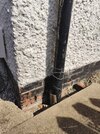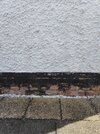Hello
I've recently moved into a 1910-20 end of tarraced house. The house is build with solid brick walls, and concrete floor on the ground floor.
On the outside it's has pebbledash render, and the bottom few rows of the bricks is painted with black paint, presumably bitumen paint or something similar.
However, as you see on the photos the paint is flaking in many places and mortar is missing in few palces too.
There is also a gutter downpipe going directly into drain. The gutter is cleaned and drain seems to be fine too. However In that corner inside the house there are signs of damp. Probably from the splashback and missing mortar.
I want to repoint the mortar in between the bricks, but not sure what to do about the paint. How to remove it in order to properly repoint.
Thanks in advance for any suggestion.
I've recently moved into a 1910-20 end of tarraced house. The house is build with solid brick walls, and concrete floor on the ground floor.
On the outside it's has pebbledash render, and the bottom few rows of the bricks is painted with black paint, presumably bitumen paint or something similar.
However, as you see on the photos the paint is flaking in many places and mortar is missing in few palces too.
There is also a gutter downpipe going directly into drain. The gutter is cleaned and drain seems to be fine too. However In that corner inside the house there are signs of damp. Probably from the splashback and missing mortar.
I want to repoint the mortar in between the bricks, but not sure what to do about the paint. How to remove it in order to properly repoint.
Thanks in advance for any suggestion.



